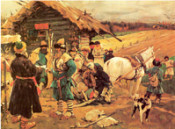
Tsar Fedor Ivanovich issues a decree on “Fixed years”
November 24 (December 4), 1597 Tsar Fedor Ivanovich issued a Decree on “fixed years” – a statute of limitations during which a run-away serf could be sought out and returned to his landlord. According to the decree the serfs, who had run away from their landlords “… five years before the current year” were subject to search, trial and return. The Decree did not apply to those who had run away six years ago or earlier.
The process of enslaving of serfs in Russia had been quite a long one and had several phases. The Code of Law of 1497 had limited the period during which a serf could “leave” his current landlord and transfer to another one, to two weeks in a year: one before Yuri’s Day (26th November) and one week after the feast. The fact that the law fixed a limited brief period of transfer proved, on the one hand, the desire of landlords and the state to limit the rights of serfs, and on the other hand, it demonstrated their inability to assign a serf to a particular landlord. This standard was reflected in the Code of Law of 1550 too. In 1581 however, in the situation of country’s devastation and escape of population, Tsar Ivan IV introduced “forbidden years” which prohibited serfs from leaving their landlords in the territories having mostly suffered from disaster. This measure was a temporary one at the time.
In the years of 1592-1593 "forbidden years" were re-introduced on the national scale by the Decree of Tsar Fedor Ivanovich, who forbade serfs from leaving and declared scribe books a legal basis fo enslavement of serfs. Information, contained in these books, stated the ownership of serfs by landowners. Thus, the census of the population was carried out, which allowed to bind serfs to their place of residence, and return them in case of escape and subsequent capture to the old masters.
The authors of the Decree of 1597 focused on scribe books, who established the so-called “fixed years” - the period of search for fugitive serfs equal to five years. After five years, fleeing serfs were subject to enslavement in new places, which met the interests of big landowners and the nobility of southern and southwestern uyezds, where the main streams of fugitives went. Therefore, the dispute over labor between the feudal lords of center and the southern regions became one of the causes of upheaval of the early 17th century.
According to Ulozheniye (a legal code) of 1607 the period of search for fugitive serfs was increased to 15 years. In the reign of Tsar Mikhail Fedorovich the five-year period of search was reintroduced. In 1630’s the term of “fixed years” was increased to 9 years, and in 1640’s – to 10 years for fugitive serfs, to 15 years – for serfs, who had been taken away by force by other landlords. Under the Sobornoye Ulozheniye of 1649 the unlimited term for search of fugitive serfs was introduced, which marked the final legalization of serfdom.
Lit.: Глухов В. П. Россия в XVI-XVII вв. М., 2001; Греков Б. Д. Крестьяне на Руси с древнейших времён доXVII в. Кн. 2. М., 1954; Корецкий В. И. Новое о крестьянском закрепощении и о восстании И. И. Болотникова Вопросы истории. 1971. № 5. С. 130—152; Скрынников Р. Г. Борис Годунов. М., 1978. Гл. 8. Заповедные и урочные годы; Скрынников Р. Г. Россия накануне «смутного времени». М., 1985.
Based on the Presidential Library’s materials:
Sobornoye Ulozhenie of Alexis of Russia promulgated // On this day. 8 February 1649

